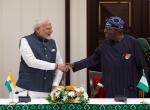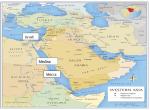Recently, three of Qatar’s most powerful neighbours decided to severe ties with the gas-rich country. Saudi Arabia, United Arab Emirates (UAE), Bahrain and Egypt announced to severe all– sea, land, air, diplomatic – linkages with Qatar. This includes not only the calling back of diplomats stationed in Qatar, but also disrupting trade via land, air and sea. It also includes debarring flights registered in Qatar to fly over the aforementioned countries. However, it does not prevent Qatar from trading with third countries.
Subsequently, other states in the region such as Yemen joined the block along with Maldives, Mauritius and Mauritania. Jordon also downgraded its diplomatic representation by revoking the license of the Doha-based TV channel, Al Jazeera; and the de- facto Eastern government based in Al– Bayda, Libya, followed its regional allies in breaking ties with Qatar. The Qatari Foreign Minister, Sheikh Mohammed bin Abdulrahman al-Thani, has claimed that this move is to undermine the independent foreign policy of Qatar.
Causes of the Crisis
The news of the apparent rift was announced on 5 June 2017. The Saudi Agency Press released a statement blaming Qatar for evading their commitments and agreements signed under the authority of the Gulf Cooperation Council (GCC) to stand against the terrorist groups and activities as outlined in the Riyadh Agreement. There are three underlying causes of tension between the state of Qatar and the other GCC states – Qatar’s support of the Muslim Brotherhood, Hamas, and its closeness with Iran.
Qatar’s relations with the Muslim Brotherhood have been the bone of contention with Egypt and the GCC states. The Muslim Brotherhood has been deemed as a terrorist organisation by Saudi Arabia and UAE. In 2014, Saudi Arabia, Bahrain and UAE had cut diplomatic linkages with Qatar. The stated cause was its ties with the Muslim Brotherhood, and certain other movements and groups that stirred unrest in the GCC. It was argued that these groups adopted orientations and policies that opposed those of the GCC. Qatar was also accused of failing to comply with the Riyadh Statement, signed in November 2013. However, after Kuwaiti mediation, it was announced by the GCC partners that unity is more important. In response, Doha asked Brotherhood leaders in Qatar to leave as pressure from the GCC states began to mount. However, it was well established that this never meant ruptured ties between Qatar and the Muslim Brotherhood.
Qatar’s ties with Iran has long been bothering its arch rival Saudi Arabia. Saudi Arabia’s problems with Iran can broadly be identified as two-fold – one, sectarian rivalry; and two, its regional ambitions. The causes of both stem from history. Saudi Arabia has criticised Iran of it notoriety in the region. Both have remained at logger’s head in Syria, Yemen, Bahrain, Lebanon and Iraq as they are on regional issues such as the Islamic State of Iraq and Syria (ISIS), funding and sponsoring terrorism and extremism, Hajj politics, interventionist agendas, and so on. Saudi Arabia has accused Qatar of supporting Iranian- backed militants in its Shiite dominated provinces of Eastern region of Qatif and Bahrain. However, Qatar has vehemently denied these claims.
Qatar’s relations with Hamas have also long irked its GCC brethren. In October 2012, the Emir of Qatar made a visit to the Hamas ruled - Gaza Strip. During this visit, Doha promised US $ 400 in aid to Hamas along with frequent oil supplies. In the same year, Hamas shifted its headquarters from Syria to Doha, after they were allegedly found training rebel groups. As Hamas’s relations with Iran started to wane after the beginning of crisis in Syria, Qatar rushed to fill the gap. In 2015, after the 2014 diplomatic row, the then Foreign Minister of Qatar, Dr. Khalid bin Mohammed Al Attiyah, confirmed that Hamas leader Khaled Meshaal was a “dear guest” living in Qatar.
Situating Trump’s Visit to Riyadh
Before the decision of severing ties with Qatar was announced, President Trump made a visit to Riyadh on 20 May 2017 to address the Arab Islamic American Summit. Commentators viewed his speech as a precursor to this diplomatic blockade. During the visit, while he acknowledged Hezbullah as a terrorist organisation, along with Al Qaeda and Hamas, he also referred to the Iranian government as one that provided terrorist and militia outfits with – safe-haven, financial backing and the social standing needed for recruitment. He also urged the leaders present there to isolate Iran referring to it as a nation that “fuelled the fires of sectarian conflict and terror”. In the Joint Statement issued by the Kingdom of Saudi Arabia and the United States, it identified Iran as a threat to the security and the stability of the region, one that instigates sectarian strife, supports terrorism and armed proxies.
However, during the sidelines of the Riyadh meeting, President Trump met Qatar’s emir, Sheikh Tamim Bin Hamad al-Thani and acknowledged the friendship it shared with Qatar and asserted that it will discuss Qatar’s purchase of military equipment . Adhering to this promise, on 14 June 2017, at an initial cost of 12 billion dollars, US and Qatar inked the defence deal for the purchase of F-15 fighters. Besides, Qatar also hosts America’s largest military base in the region. Thus, after the blockade was announced, State Department spokeswoman Heather Nauert stated that the American operations in Qatar will remain unaffected.
Likewise, with respect to funding terrorism in the region, the country reports on terrorism published by the US State Department in 2015 , mentioned entities and individuals within Qatar serving as a source of funding for regional Al Qaeda affiliates like the Al Nusrah front. However, the same was mentioned about Saudi Arabia. Contrastingly, while President Trump endorsed the move, Pentagon urged the GCC states to maintain unity and offered to mediate. Again, despite Trump’s initial show of support, the defence deal and the continued presence of US bases shows that Qatar remains part of the US bloc.
Consequences of the Blockade
In a recent statement, Mutlaq al-Qahtani, a senior counter-terrorism adviser to Qatar's Foreign Minister, said that Qatar has never supported terrorism in the past nor will it support terrorism in the future. He blamed the Gulf States for their policy of dominating and penalising Qatar for following its independent foreign policy. However, he said that Qatar will not give into these moves.
It has been argued that the recent blockade will severely affect the food imports of Qatar. According to the World Bank data, in 2015, the top partner countries and regions from which Qatar imports food products included UAE, Saudi Arabia, Germany, United States and France. However, UAE and Saudi Arabia constitute 15 and 14 percent, respectively, of its total global food product imports. In terms of Qatar’s total imports (of all products), UAE and Saudi Arabia stand at 6th and 7th position according to the World Bank data1. Thus, to claim that Qatar will face a severe food crisis due to the recent blockade would be an overestimation.
Despite other powers, like Iran and Turkey, from the region coming to the rescue of Qatar’s impending food crisis, the decision to cut land and air link will probably prove costlier on Qatari pockets, if not impossible to substitute. According to the UAE Civil Aviation authority, the embargo on flights are limited only to those flights that are registered in Qatar and owned by Qatari aviation companies from landing or transiting through the air space of UAE, Saudi Arabia and Riyadh. While it may be easier for Iran to reach Qatar via sea, Turkey is geographically further away with no direct land or sea connectivity. This implies that Qatar might have to incur higher transportation costs due to change in air routes. Besides, with the ban on flights, Qatar will definitely miss out on the lucrative businesses for its state owned Qatar Airways. Airlines such as Emirates (Dubai based) and Etihad (Abu Dhabi based) have been asked to stop its services to Qatar. Qatar has in recent years developed as an important transit hub and have made a mark in proving luxurious international services to increasing number of destinations across continents.
The Qatari National Bank (QNB), Qatar’s largest of the top five banks with 50 percent owned by the government via Qatar Investment Authority, has acquired stakes in the region, in Egypt, UAE, Iraq, Tunisia, Syria, to name a few. With the upcoming FIFA 2022 world cup scheduled to be held in Qatar, the Qatari banks have already outstretched their finances. Since most of Qatar’s domestic banking is reliant on foreign funding, to acquire liquidity from its regional partners can be challenging. However, none of the Qatari banks, with their branches in the region, have received any guidelines for halting operations in their respective state branches.
Qatar is the largest exporter of Liquefied Natural Gas (LNG). Therefore, the biggest concern following the diplomatic crisis was its gas supplies. Most of Qatar’s reserves are located in the north field, bordering Iran. According to the World Bank, in 2015, Qatar’s global export of liquefied natural gas was US dollar 50,522,864.20 million. Its top five trading partners include Japan, Korea, India, China and UAE. In a statement by the Qatari Foreign Minister, he assured that the LNG agreements made with UAE will be respected. Qatar has historically sold most of its LNG through long-term sales and purchase agreements wherein its partners pay higher prices for long term steady supplies, thereby making it advantageous for Qatar. These contract are to last from 2020 to 2025.Qatar also signed a long term agreement with Dolphin Energy, UAE, in 2016 with the additional amount earmarked for Sharjah Electricity and Water Authority and Ras Al Khaimah. Therefore, this crisis is less likely to affect either supply or price of LNG for Qatar’s regional or global partners.
Yet another cause of concern was the presence of foreign nationals in Qatar, a significant percentage of its work force. According to the data compiled by Gulf Labour Markets and Migration (GLMMC), it was estimated that in 2013, out of a total 1,543,265 strong labour force, 1,450,703 were non-nationals. Of those, 1,448,007 were employed, making it 94.1 percent of the total employed population in Qatar.
The following graph shows the estimated number of foreign nationals residing in Qatar during 2014.
| Country | Population | Percentage |
|---|---|---|
| 1.India | 545,000 | 23.58 |
| 2.Nepal | 400,000 | 17.3 |
| 3.Qatar | 278,000 | 12.03 |
| 4.Philippines | 200,000 | 8.65 |
| 5. Egypt | 180,000 | 7.78 |
Of the top five countries constituting foreign nationals in Qatar, Egypt holds the 5th position. However, according to Al Ahram, Egyptian news agency, so far there has been no directive for the Egyptians residing in Qatar, the current estimation of which stands at 300,000. Mohammed el-Iraqi, the spokesman for the Egyptian community in Qatar, has also said that the crisis has not yet impacted businesses for Egyptians residing in Qatar. However, the labour chief of Philippines, Silvestre Bello, has issued a directive of halting further migrations to Qatar as it fears the ‘ripple’ effect and problems of food security. There are no plans for the return of those in the state of Qatar.
Implications for India
Indian migrants constitute the largest percentage of foreign immigrants in Qatar. India’s annual import of LNG from Qatar is estimated to be 7.5 million metric tons. This accounts to 65 percent of India’s global LNG imports and 15 percent of Qatar’s global exports. In 2004, the Indian gas company, Petronet, signed an agreement of 25 years with Qatar, the supply of which began in 2010. In 2014, India also purchased spot cargo worth 0.8 million tons of LNG from Ras Gas, Qatar. This makes India one of the most important trade partners for Qatar. Apart from LNG, India also imports ethylene, propylene, ammonia, urea and polyethylene from Qatar. Right after the decision to cut ties was announced, Indian Minister of External Affairs, Sushma Swaraj, made a statement saying that the matter is internal to the GCC and that India need not interfere in the internal affairs of the GCC. However, India will secure the safety of the workers present in Qatar. Thus, it is unlikely that India will have to face immediate consequences of this decision in terms of its gas supplies as well as expatriate population. Besides, India also shares cordial relationship with other GCC states.
Conclusion
Though this crisis can be viewed as a result of GCC’s long standing issues with Qatar, it is unlikely for Qatar to acquiesce. The stated political accusation against Qatar are not new. Since these causes did not produce desired results for the GCC brethren in 2014, it is less likely to do so this time. Besides, given Qatar’s posturing and reaction to the move, it appears that the country is ready to make changes than get coerced. Moreover, with the change in leadership in Saudi Arabia with the 31 years old Mohammed bin Salman being made the next crown prince, the possibility of rapprochement becomes more distant.
However, the crisis can create fault lines within the GCC given actions by Saudi Arabia has not yet brought Qatar to the negotiating table. Moreover, this can result in the weakening of the GCC as an institution. This also implies a weakened anti- Iran front, which is counter-productive for both the US and Saudi Arabia. It also leaves space for Iran and Turkey to enter the Persian Gulf, a phenomenon which both have resisted since long and is now apparent.
Economically, the blockade may affect its FIFA preparations due to lack of cash liquidity. However, given Qatar’s ties with the friendly states in the region, it may not have a tough time finding solutions or adjusting to the crisis. It might also have negligible effects on its National Vision, albeit short term. However, if the crisis persists, its effects may become ostensible once its long term gas deals terminate.
Endnotes
1. China, 2. North America, 3. United States, 4. Germany, 5. Japan, 6. United Kingdom, 7. Italy, 8. Saudi Arabia.
Image Source: http://jewishjournal.com/wp-content/uploads/2017/06/qatar.jpg








.jpg)


Post new comment